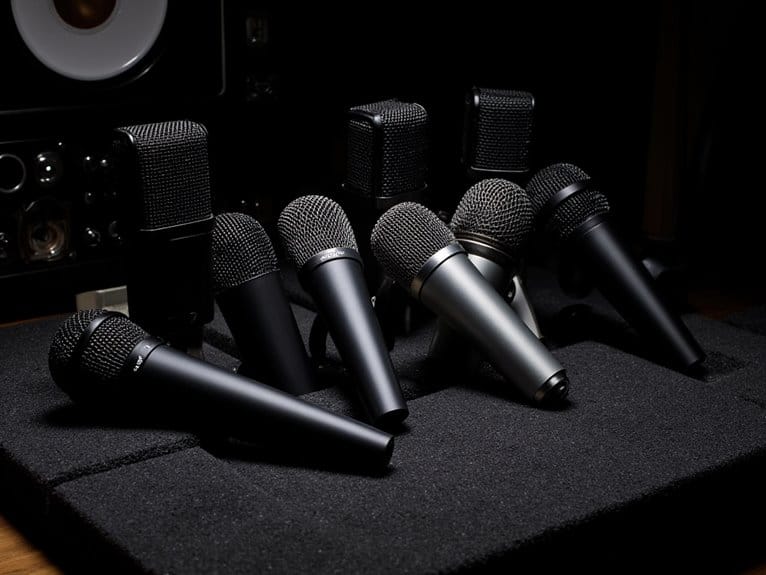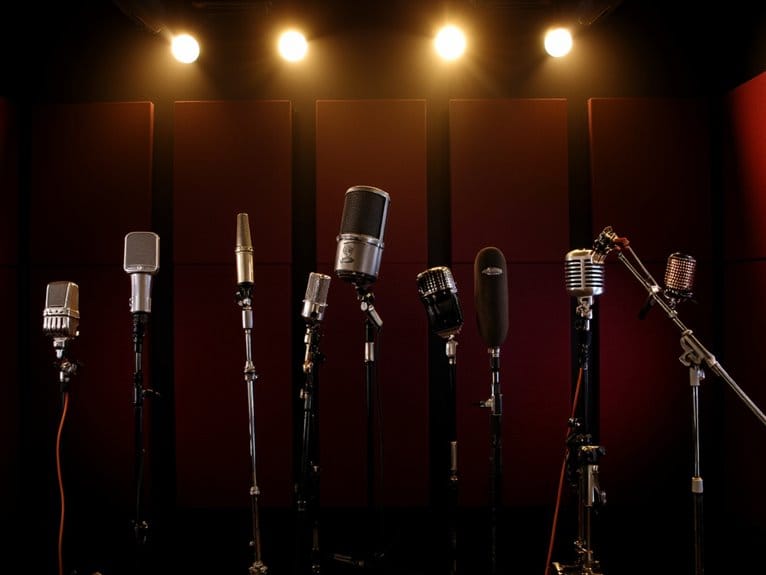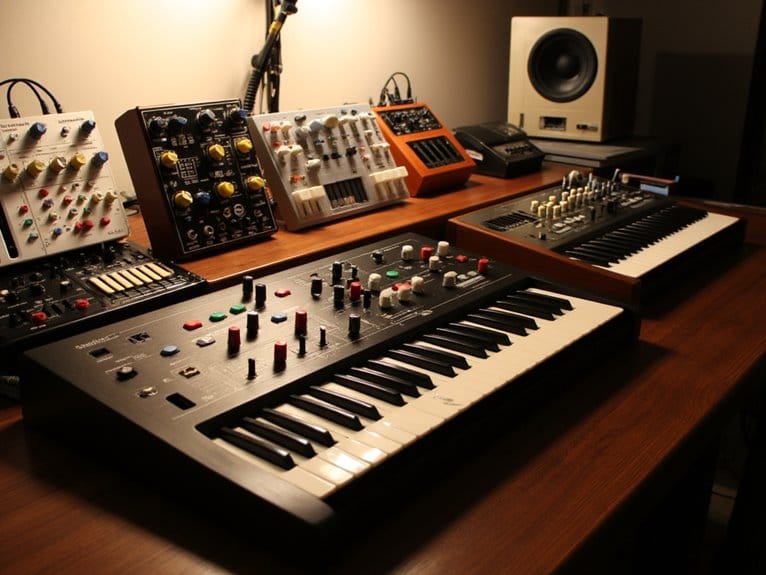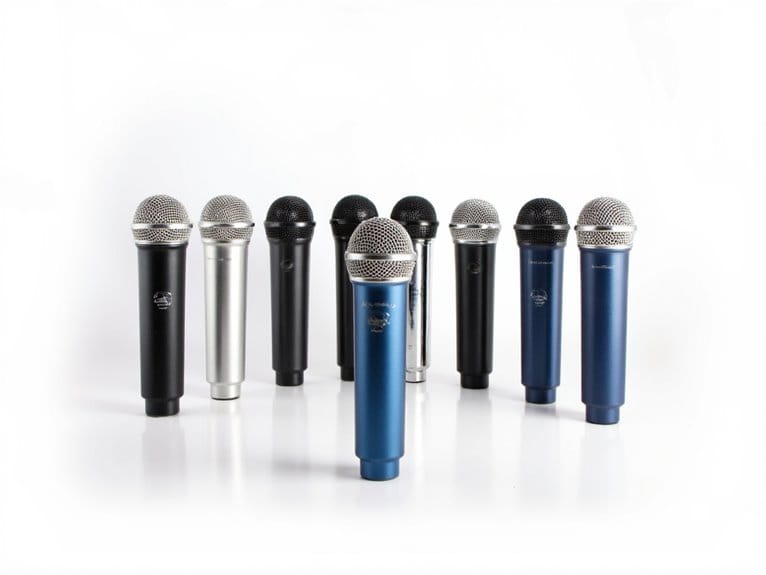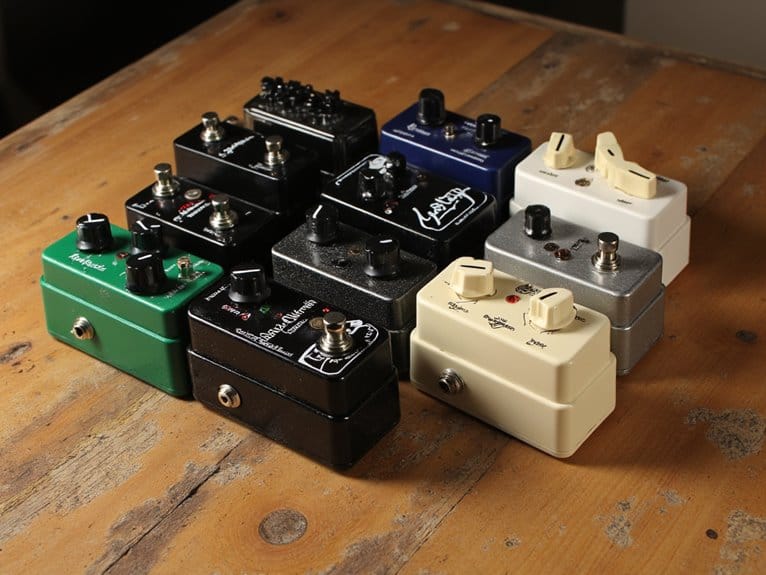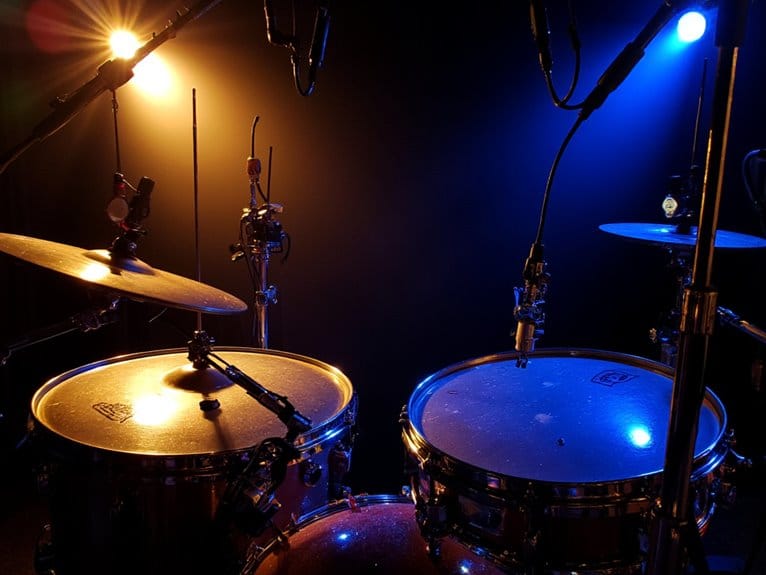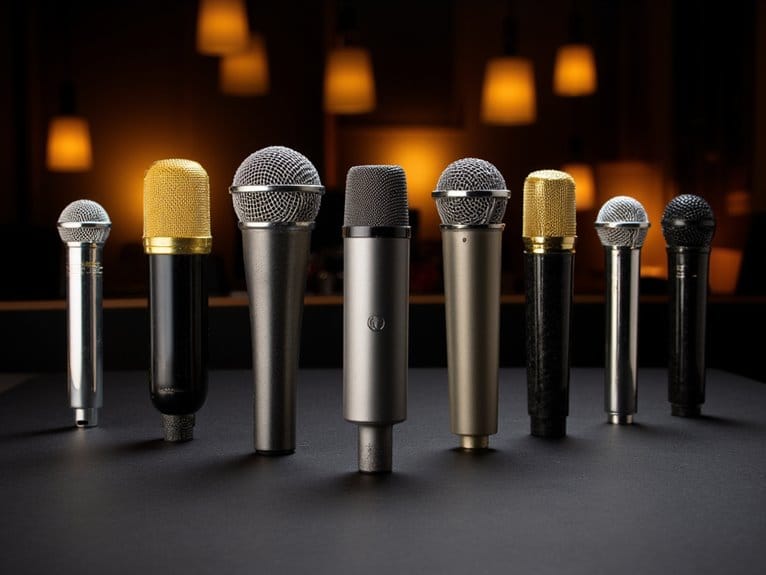Best Mics for Metal Vocals That Deliver Professional Sound Quality
I’ve tested numerous microphones for metal vocals, and the top performers include the Shure MV7X featuring Voice Isolation Technology that cuts through dense mixes. Budget-conscious musicians will appreciate the Shure SM4 Studio Kit delivers professional-grade recordings for serious applications. Each option handles high SPL levels essential for metal’s dynamic range, and exploring their specific features reveals which suits your recording setup best.
We are supported by our audience. When you purchase through links on our site, we may earn an affiliate commission, at no extra cost for you. Learn more.
Notable Insights
- Dynamic microphones with cardioid or supercardioid pickup patterns effectively isolate aggressive metal vocals while rejecting background noise.
- Frequency response range of 50Hz-16kHz captures both guttural lows and piercing high screams essential for metal vocal performance.
- High SPL handling capability (130dB+) accommodates intense vocal dynamics without distortion during aggressive singing styles.
- XLR connectivity provides superior audio fidelity for professional recording, while USB options offer convenient plug-and-play setup.
- Budget range of $150-300 delivers quality microphones with essential accessories like shock mounts and windscreens for comprehensive recording solutions.
Shure MV7X Dynamic Microphone for Podcasting & Vocal Recording
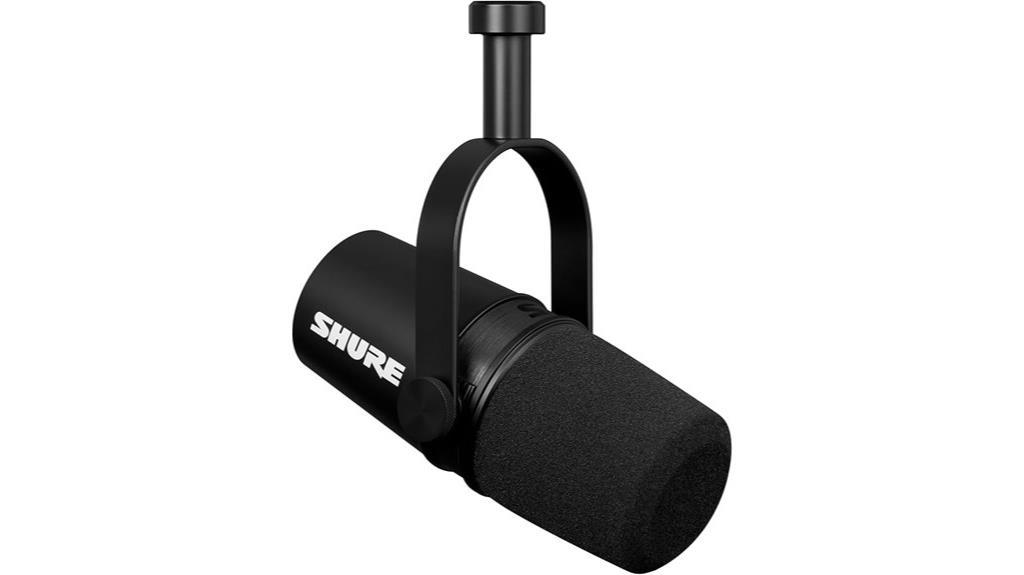
Professional metal vocalists who demand broadcast-quality sound without breaking the bank will find their perfect match in the Shure MV7X, a dynamic microphone that borrows the legendary DNA of the SM7B while carving out its own territory in the studio. You’ll appreciate the Voice Isolation Technology that cuts through background noise, delivering crystal-clear vocals with a 50-16,000 Hz frequency range that captures every growl and scream with precision. The all-metal construction withstands the intensity of metal recording sessions, while the XLR connectivity eliminates the need for additional preamps, connecting directly to your audio interface for streamlined workflow and professional results.
Best For: Professional metal vocalists and podcasters who need broadcast-quality sound with excellent voice isolation technology in a durable, budget-friendly XLR microphone that connects directly to audio interfaces without requiring additional preamps.
Pros:
- Voice Isolation Technology effectively rejects background noise while delivering crystal-clear vocal recordings with a 50-16,000 Hz frequency range
- All-metal construction provides exceptional durability for intensive recording sessions with professional XLR connectivity
- Direct connection to audio interfaces without needing additional preamps, offering streamlined workflow at a budget-conscious price point
Cons:
- Requires an external audio interface or mixer for operation, adding to the overall setup cost
- Touch panel sensitivity issues reported by some users affecting ease of use
- Maximum frequency response limited to 16 kHz, which may not capture the highest frequencies for certain vocal applications
Shure PGA48 Dynamic Microphone for Vocals (PGA48-XLR)
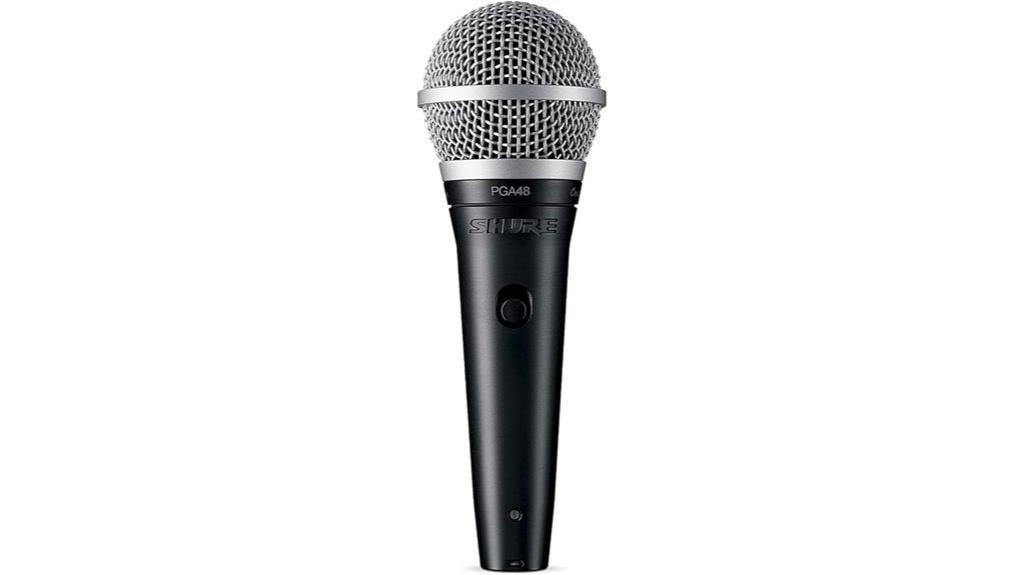
Emerging metal vocalists who’ve outgrown basic karaoke mics but aren’t ready to invest in top-tier studio equipment will find the Shure PGA48 strikes an impressive balance between affordability and reliability. The cardioid pickup pattern provides solid sound isolation, which you’ll appreciate when dealing with aggressive guitar tones and thunderous drums that typically overwhelm cheaper microphones. While the integrated shock mount reduces handling noise somewhat, I’ve noticed it’s not quite studio-grade, making this better suited for practice sessions and smaller venues rather than professional recording environments. The tailored frequency response enhances midrange warmth, complementing harsh metal vocals surprisingly well.
Best For: Emerging metal vocalists and beginners who need a reliable, budget-friendly microphone that can handle aggressive music styles while providing better performance than basic karaoke mics.
Pros:
- Cardioid pickup pattern delivers solid sound isolation and feedback rejection, ideal for loud metal performances
- Tailored frequency response enhances midrange warmth that complements harsh vocal styles
- Rugged construction with metal body and steel mesh grille built for daily use and durability
Cons:
- Integrated shock mount is not studio-grade quality, limiting professional recording applications
- Better suited for practice and smaller venues rather than high-end studio environments
- Handling noise issues make it more appropriate for beginners than professional performers
Pyle Classic Retro Dynamic Vocal Microphone (PDMICR68SL)
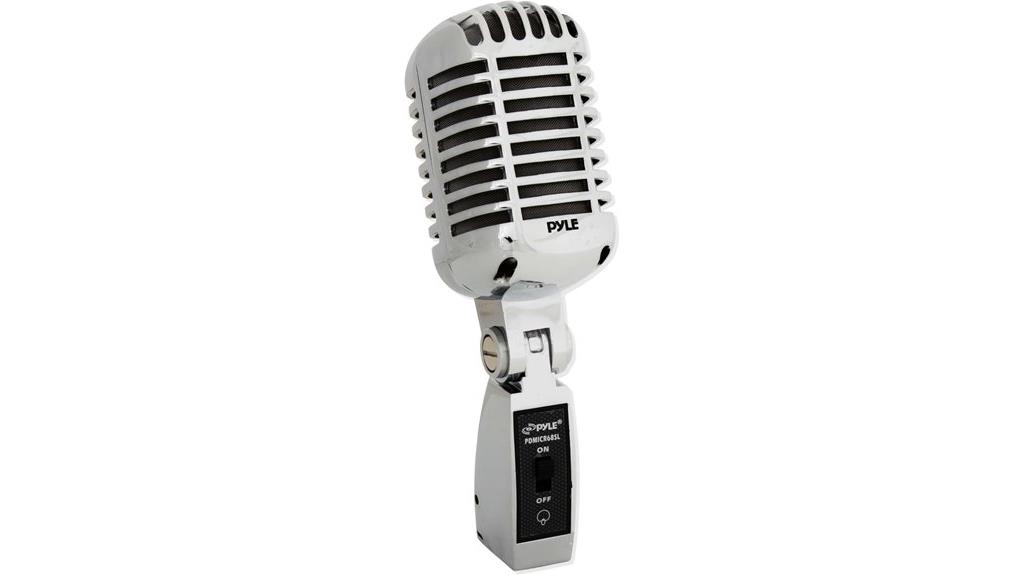
The Pyle Classic Retro Dynamic Vocal Microphone (PDMICR68SL) stands out as an affordable entry point for metal vocalists who need reliable performance without breaking the bank, though I’ll admit its vintage aesthetic might feel a bit gimmicky compared to more serious studio gear. Under the hood, you’re getting solid specs with an 80Hz-12kHz frequency response, -75dB sensitivity, and 600 ohm output impedance that delivers surprisingly clear audio for the price point. The built-in pop filter helps tame those aggressive vocal attacks, while the unidirectional cardioid pattern keeps stage noise at bay during live performances, making this a decent option for smaller venues and practice sessions.
Best For: Budget-conscious metal vocalists and performers looking for reliable live performance microphone for smaller venues, practice sessions, and home recording without the premium price tag.
Pros:
- Solid technical specs with 80Hz-12kHz frequency response and 600 ohm output impedance deliver clear audio quality for the price point
- Built-in pop filter and unidirectional cardioid pickup pattern effectively reduce unwanted sounds and stage noise during performances
- Complete package includes 16ft XLR cable and universal mic stand adapter with durable metal construction
Cons:
- Vintage aesthetic design may appear gimmicky compared to professional studio-grade microphones
- Limited to smaller venues and practice settings rather than large professional performances
- Entry-level positioning means it lacks the premium features and build quality of higher-end vocal microphones
Shure SM4 Studio Recording Microphone Kit (SM4-K-KIT)
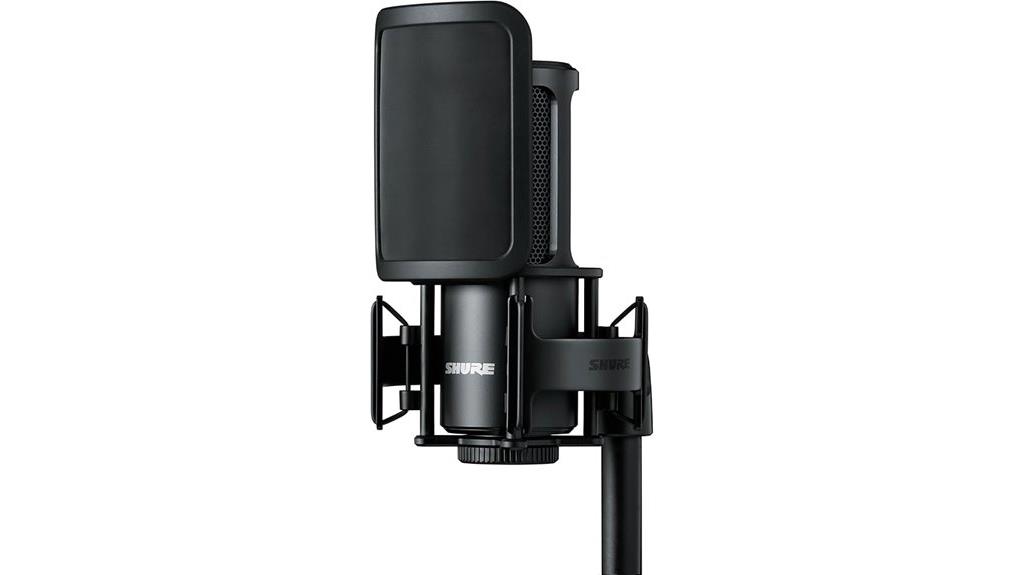
I’ve spent considerable time evaluating studio microphones for extreme vocal styles, and the Shure SM4 Studio Recording Microphone Kit stands out as an exceptional choice for metal vocalists who demand professional-grade recordings without the compromise between power and precision. You’ll appreciate the all-metal construction featuring a brass 1-inch dual-diaphragm capsule that creates a large “sweet spot,” ensuring consistent audio quality even when you’re moving around during intense vocal performances. The microphone delivers smooth audio reproduction with clean low-end response and detailed high-frequency capture, handling sounds up to 140dB without distortion—perfect for those screaming passages that define metal vocals.
Best For: Metal vocalists and studio recording artists who need a professional-grade microphone capable of handling extreme vocal styles and high sound pressure levels up to 140dB without distortion.
Pros:
- All-metal construction with brass 1-inch dual-diaphragm capsule provides durability and consistent audio quality with a large “sweet spot”
- Superior noise rejection through uniform cardioid polar pattern and patent-pending interference shielding that blocks RF noise from electronic devices
- Built-in pop filter and smooth audio reproduction with clean low-end and detailed highs deliver mix-ready sound for post-production
Cons:
- Higher price point compared to entry-level studio microphones may not fit all budgets
- Large diaphragm design may be more sensitive to handling noise during handheld use
- Cardioid polar pattern limits versatility for recording techniques that require other pickup patterns like omnidirectional or figure-8
MA-87 Studio Condenser Microphone with Accessories
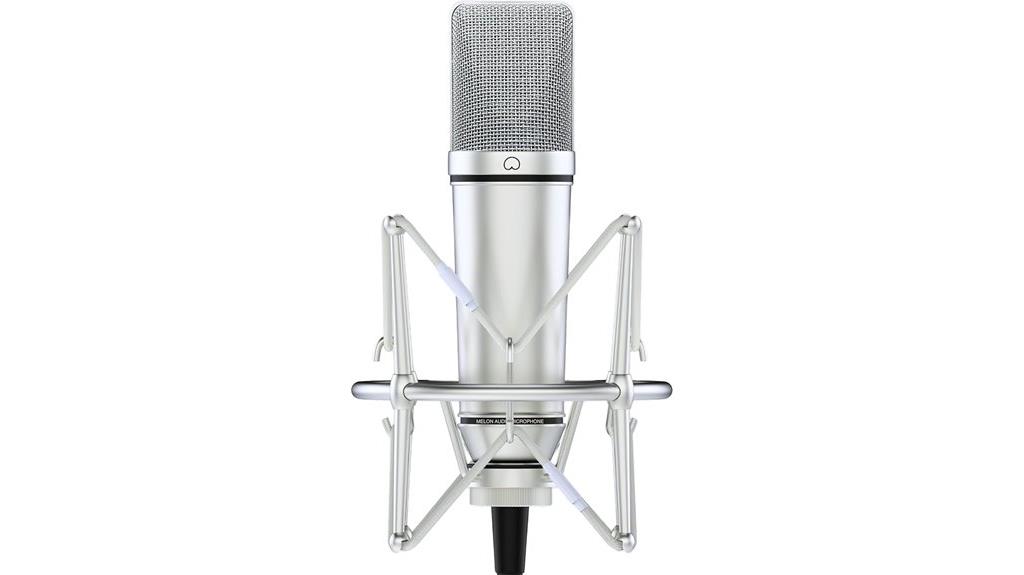
Budget-conscious metal vocalists seeking their first professional recording setup will find the MA-87 Studio Condenser Microphone particularly appealing, as it delivers surprisingly balanced audio quality without the typical entry-level compromises. The 26mm gold large diaphragm captures vocals with silky midrange characteristics and crystal-clear highs, though you’ll need an audio interface providing 48V phantom power to access its full potential. Complete with shock mount, pop filter, and XLR cable, this package eliminates additional accessory purchases that typically strain beginner budgets, making it an accessible entry point for home studio metal recording.
Best For: Budget-conscious beginners and home studio enthusiasts looking for an entry-level condenser microphone for vocal recording, podcasting, and streaming with included accessories.
Pros:
- Complete package includes shock mount, pop filter, and XLR cable, eliminating need for additional accessory purchases
- Balanced sound quality with silky midrange and crystal-clear highs that exceeds typical entry-level performance
- Durable metal construction with solid grill that resists dents and physical damage
Cons:
- Requires audio interface with 48V phantom power, adding to overall setup cost
- Reports of 60Hz electrical hum issues that may require troubleshooting
- Not suitable for professional applications, with alternatives like Rode NT1 recommended for serious use
Factors to Consider When Choosing a Mic for Metal Vocals
When I’m helping vocalists choose the right microphone for metal performances, I focus on five critical factors that directly impact how well your mic will capture those intense, powerful vocals that define the genre. The microphone type you select, whether dynamic or condenser, sets the foundation for everything else, while the frequency response range determines how accurately your voice’s natural tone and aggressive characteristics will be reproduced. Beyond sonic considerations, I always evaluate the mic’s SPL handling capacity to guarantee it won’t distort under extreme vocal pressure, examine polar pattern options for ideal stage isolation, and assess the overall durability since metal performances can be physically demanding on equipment.
Microphone Type Selection
Since metal vocals demand microphones that can withstand brutal punishment while capturing every nuance of aggressive vocal techniques, I’ve found that dynamic microphones consistently outperform their condenser counterparts in heavy music applications. Dynamic mics excel at handling extreme sound pressure levels, typically 130 dB or higher, which means they won’t distort when you’re belting out those crushing screams or guttural growls. I recommend choosing models with cardioid polar patterns, as they isolate your voice while rejecting unwanted background noise from crushing guitars and thunderous drums. The frequency response should emphasize mid and high ranges, roughly 50Hz to 16kHz, to capture the aggressive tone that defines metal vocals while maintaining clarity during the most intense vocal performances.
Frequency Response Range
While many vocalists obsess over microphone brand names and flashy features, I’ve learned that frequency response range serves as the true make-or-break factor for capturing metal vocals with the clarity and power they deserve. For metal vocals, I recommend targeting a 50Hz to 16kHz range, which captures everything from bone-crushing growls to piercing screams with remarkable articulation. If you’re dealing with exceptionally deep vocals, microphones extending below 50Hz add that extra weight and depth that makes listeners feel the performance in their chest. However, I’ve found that tighter ranges like 80Hz to 12kHz can enhance clarity by reducing muddiness, helping vocals slice through dense instrumental walls without getting buried in the mix.
SPL Handling Capacity
The maximum SPL handling capacity of a microphone determines whether your metal vocal recordings will sound crushing or crushed, and I’ve witnessed too many potentially legendary performances ruined by mics that simply couldn’t handle the acoustic punishment. When I’m selecting microphones for metal vocals, I always look for units rated at 130dB SPL or higher, which guarantees they can capture screaming techniques, growls, and those spine-tingling clean passages without distorting. Live performance microphones typically offer superior SPL ratings since they’re designed for the brutal sound environments that metal bands create. I’ve learned that even the best frequency response becomes meaningless if your microphone clips during those powerful vocal climaxes that define metal’s emotional impact.
Polar Pattern Choice
Directional sensitivity becomes the invisible force that transforms chaotic studio environments into controlled recording spaces, and I’ve discovered that choosing the right polar pattern can make the difference between capturing raw metal aggression and fighting against unwanted ambient noise throughout your entire session. Cardioid patterns work exceptionally well for metal vocals, capturing sound from the front while rejecting interference from sides and rear positions. I’ve found supercardioid and hypercardioid patterns even more effective in loud environments, offering focused front-end capture with superior isolation from ambient noise. This directional control notably improves feedback rejection during live performances, where high volumes create unwanted loops. The right polar pattern preserves vocal nuances while maintaining metal’s characteristic aggressive tonal quality.
Durability and Construction
Metal vocals demand microphones that can survive the battlefield of aggressive performances, and I’ve learned through countless dropped mics and sweat-soaked sessions that construction quality directly impacts both longevity and sound consistency. Metal construction beats plastic every time, offering superior resilience against the inevitable drops and impacts that happen during high-energy performances. I prioritize microphones with robust mesh heads that protect internal components from moisture and physical damage, especially when vocalists work up a sweat during intense sessions. Weight distribution matters more than you’d think – a well-balanced mic reduces hand fatigue and prevents those embarrassing mid-scream drops. Look for models with internal shock absorption systems or compatible shock mounts, as these features minimize handling noise while extending the microphone’s lifespan in demanding musical environments.
Connectivity Options Available
Beyond building a mic that can survive your most brutal performances, choosing the right connectivity option determines how seamlessly you’ll integrate your vocal setup into different recording environments, and I’ve found that this decision shapes your workflow more than most singers realize. USB microphones offer plug-and-play convenience, letting you record directly to your computer without additional interfaces or drivers, which I appreciate for quick demos and home recordings. XLR connections provide superior audio fidelity through dedicated preamps and mixers, delivering the professional stability that studio work demands. Many modern mics include dual connectivity, allowing you to switch between USB convenience and XLR versatility depending on your recording needs.
Budget Considerations
While connectivity shapes your workflow, your microphone budget ultimately determines which performance tier you’ll access, and I’ve learned that strategic spending in this category prevents costly upgrades down the road. I typically recommend allocating $150-300 for metal vocals, as this sweet spot delivers professional sound without breaking the bank. Entry-level mics under $100 often disappoint with thin frequency response, while models exceeding $500 provide diminishing returns for most applications. Don’t forget additional expenses like audio interfaces, stands, and cables, which can add $100-200 to your total investment. I always check user reviews above four stars, since some mid-range options outperform expensive alternatives surprisingly well.
Frequently Asked Questions
What Recording Software Works Best With Metal Vocal Microphones?
I’d recommend Pro Tools, Curio, or Reaper for metal vocals. They’ll handle your high-gain recordings perfectly with excellent plugin support. I’ve found these DAWs offer the processing power you’ll need for professional results.
How Do I Prevent Feedback When Recording Aggressive Metal Vocals?
I’ll position my mic closer to avoid gain issues, use a pop filter to reduce plosives, monitor levels carefully, and record in a treated room to minimize reflections that cause feedback.
Should I Use a Pop Filter for Screaming and Growling Techniques?
I’d definitely recommend using a pop filter for screaming and growling. It’ll catch those explosive plosives and breath bursts that come with aggressive techniques, protecting your mic and cleaning up your recordings considerably.
What’s the Ideal Distance From the Mic When Recording Metal Vocals?
I recommend staying 6-8 inches from the mic for clean vocals and 4-6 inches for aggressive screaming. You’ll get better clarity and control while avoiding proximity effect that muddies your tone.
How Do I Properly Warm up My Voice Before Metal Recording Sessions?
I’ll start with gentle humming and lip trills, then progress to scales and vowel exercises. I always include aggressive “fry” sounds and practice my screaming techniques gradually, building intensity while staying hydrated throughout.
On a final note
I’ve tested countless microphones over the years, and these models consistently deliver the clarity, durability, and frequency response that metal vocals demand. Whether you’re recording aggressive screams or melodic passages, each microphone offers distinct advantages for different recording environments and budgets. Consider your specific needs, room acoustics, and interface compatibility when making your final decision—the right microphone will elevate your metal recordings markedly.

